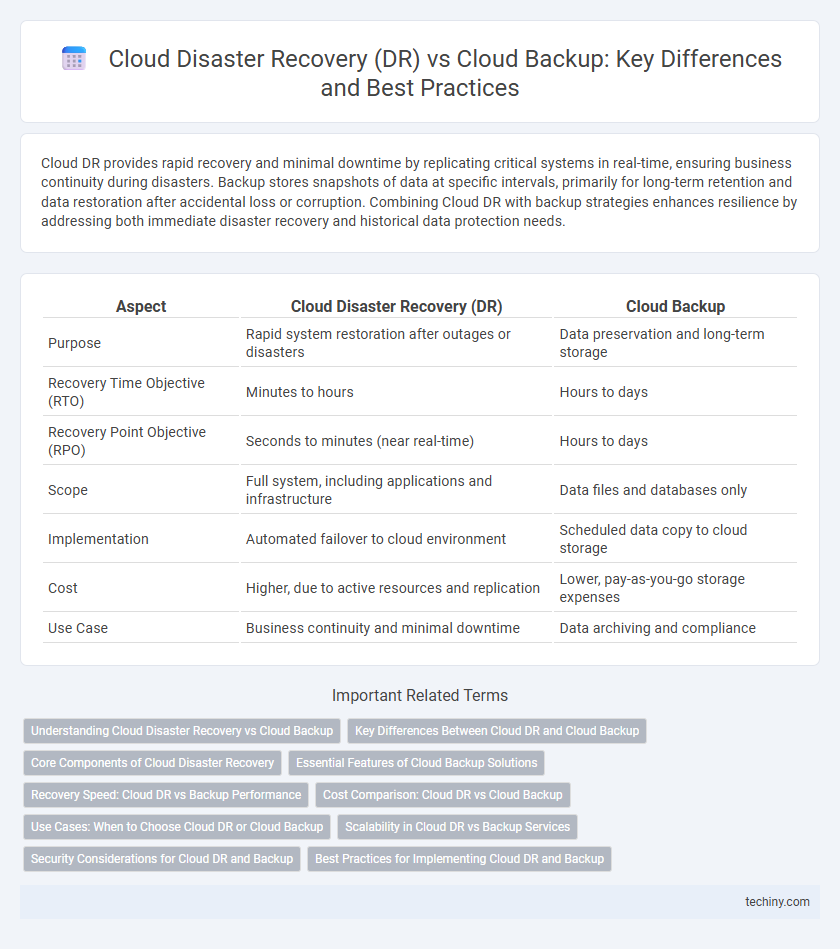Cloud DR provides rapid recovery and minimal downtime by replicating critical systems in real-time, ensuring business continuity during disasters. Backup stores snapshots of data at specific intervals, primarily for long-term retention and data restoration after accidental loss or corruption. Combining Cloud DR with backup strategies enhances resilience by addressing both immediate disaster recovery and historical data protection needs.
Table of Comparison
| Aspect | Cloud Disaster Recovery (DR) | Cloud Backup |
|---|---|---|
| Purpose | Rapid system restoration after outages or disasters | Data preservation and long-term storage |
| Recovery Time Objective (RTO) | Minutes to hours | Hours to days |
| Recovery Point Objective (RPO) | Seconds to minutes (near real-time) | Hours to days |
| Scope | Full system, including applications and infrastructure | Data files and databases only |
| Implementation | Automated failover to cloud environment | Scheduled data copy to cloud storage |
| Cost | Higher, due to active resources and replication | Lower, pay-as-you-go storage expenses |
| Use Case | Business continuity and minimal downtime | Data archiving and compliance |
Understanding Cloud Disaster Recovery vs Cloud Backup
Cloud Disaster Recovery (DR) involves replicating and maintaining critical IT infrastructure and data in the cloud to enable rapid recovery from system failures, natural disasters, or cyberattacks, minimizing downtime and data loss. Cloud Backup focuses on securely storing data copies in the cloud for retrieval and restoration in case of accidental deletion, corruption, or hardware failure, but does not typically provide real-time systems recovery. Understanding the distinction highlights that Cloud DR ensures business continuity through comprehensive system replication, whereas Cloud Backup primarily safeguards data integrity.
Key Differences Between Cloud DR and Cloud Backup
Cloud DR (Disaster Recovery) focuses on replicating and restoring entire IT environments to ensure business continuity during major outages, whereas Cloud Backup involves creating copies of data for long-term retention and recovery from data loss or corruption. Cloud DR typically enables faster recovery times and supports failover systems, while Cloud Backup provides incremental or full data snapshots stored securely in the cloud. Key differences include recovery time objectives (RTO), recovery point objectives (RPO), and the scope of restoration, with Cloud DR offering comprehensive system recovery and Cloud Backup concentrated on data restoration.
Core Components of Cloud Disaster Recovery
Cloud disaster recovery (DR) involves real-time replication, orchestration, and failover of critical systems to ensure business continuity, contrasting with traditional backup's focus on data storage and restoration. Core components include automated failover mechanisms, continuous data replication, and cloud-based orchestration tools that minimize downtime during outages. These elements work together to provide seamless recovery, enabling rapid restoration of IT infrastructure and applications in cloud environments.
Essential Features of Cloud Backup Solutions
Cloud backup solutions provide continuous data protection, automated recovery point creation, and scalable storage options to ensure rapid restoration after data loss events. Essential features include encryption for secure data transfer and storage, incremental backups to optimize bandwidth and storage efficiency, and cross-region replication for enhanced disaster resilience. These capabilities differentiate cloud backup from traditional disaster recovery by focusing on seamless data preservation and accessibility rather than full infrastructure restoration.
Recovery Speed: Cloud DR vs Backup Performance
Cloud Disaster Recovery (DR) offers significantly faster recovery speeds compared to traditional cloud backup solutions by enabling near-instant failover and minimal downtime during system failures. Backup solutions primarily focus on data preservation and require time-consuming restoration processes, leading to longer recovery point objectives (RPO) and recovery time objectives (RTO). Cloud DR leverages real-time replication and automated orchestration, optimizing performance for critical business continuity and rapid disaster mitigation.
Cost Comparison: Cloud DR vs Cloud Backup
Cloud Disaster Recovery (DR) generally incurs higher costs than Cloud Backup due to the need for continuous replication, real-time failover, and comprehensive infrastructure readiness. Cloud Backup primarily involves periodic data snapshots stored at lower frequencies, resulting in lower storage and retrieval expenses. Budget considerations should weigh the criticality of minimal downtime in Cloud DR against the cost-effectiveness of Cloud Backup's data preservation strategy.
Use Cases: When to Choose Cloud DR or Cloud Backup
Cloud Disaster Recovery (DR) is ideal for organizations requiring rapid system restoration and minimal downtime after critical failures or cyberattacks, especially in sectors like finance and healthcare where uptime is crucial. Cloud Backup suits businesses focused on long-term data preservation, regulatory compliance, and cost-effective data archiving without the immediate need for system recovery. Choosing between Cloud DR and Cloud Backup depends on recovery time objectives (RTO), recovery point objectives (RPO), and specific business continuity requirements.
Scalability in Cloud DR vs Backup Services
Cloud Disaster Recovery (DR) services offer dynamic scalability by rapidly provisioning resources during an outage, ensuring minimal downtime and data loss. In contrast, traditional backup services often rely on fixed storage capacity, limiting their ability to scale efficiently under sudden demand spikes. Elastic scalability in Cloud DR leverages virtualized infrastructure and automated failover mechanisms, optimizing resilience and recovery speed across distributed environments.
Security Considerations for Cloud DR and Backup
Cloud Disaster Recovery (DR) emphasizes rapid recovery and continuous availability, requiring robust encryption, identity access management, and compliance adherence to protect critical data during failover scenarios. Cloud backup solutions prioritize secure data storage with end-to-end encryption, immutable snapshots, and multi-factor authentication to prevent unauthorized access and ransomware attacks. Both strategies demand rigorous security frameworks, including regular vulnerability assessments and real-time monitoring, to ensure data integrity and confidentiality in cloud environments.
Best Practices for Implementing Cloud DR and Backup
Effective cloud disaster recovery (DR) and backup strategies require regular data replication, automated failover processes, and comprehensive testing to ensure business continuity. Implementing geographically diverse data centers enhances fault tolerance, while maintaining versioned backups and encrypted storage safeguards data integrity and security. Integrating monitoring tools and defining clear recovery time objectives (RTO) and recovery point objectives (RPO) optimizes recovery efforts and minimizes downtime in cloud environments.
Cloud DR (Disaster Recovery) vs Backup Infographic

 techiny.com
techiny.com